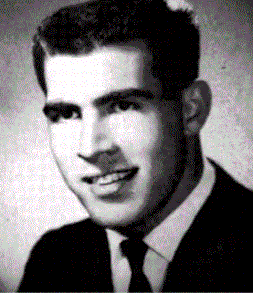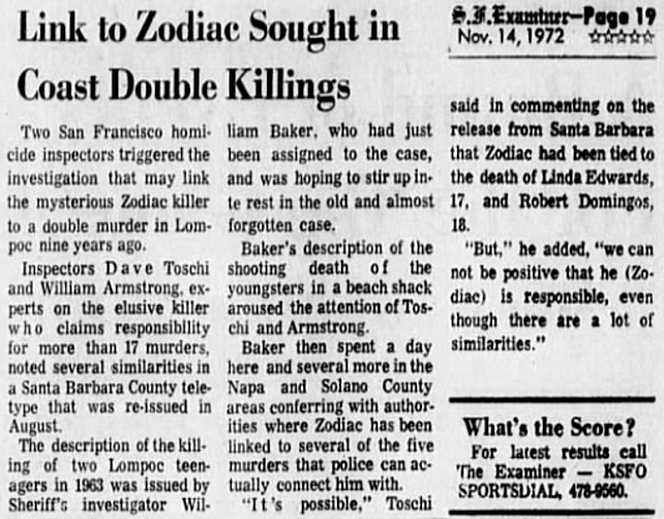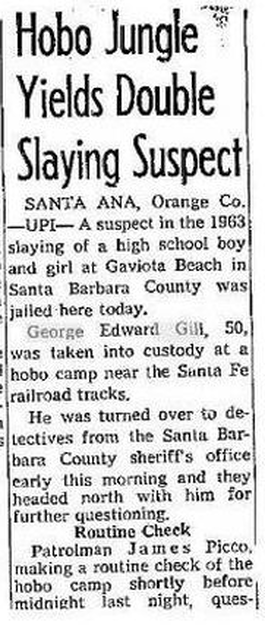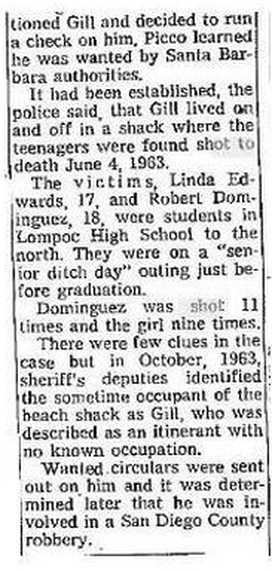|
Here are seven in depth articles examining the murders of Robert Domingos and Linda Edwards. The Ballistics. The Shack. The Rope. The Beach. The Ammo. Pistol or Rifle? The Final Analysis.
 1956 PONTIAC 1956 PONTIAC
Bill Baker, a now retired Santa Barbara detective, believed that the early murders of Robert Domingos (18) and Linda Edwards (17) on June 4th 1963 carried many of the hallmarks of the now notorious Zodiac Killer, who terrorized part of Northern California in the late 1960s and early 1970s.
Sixty-one years ago, a couple were brutally executed while fleeing for their lives from a remote Santa Barbara beach, situated 3.32 miles east of Gaviota State Park, alongside Highway 101, approximately five hours from Vallejo, California. It was a sunny afternoon when the killer first encountered the couple, armed with what was thought to be a .22 caliber long rifle (a weapon ideal for target shooting with minimum recoil). The couple were Robert Domingos (18) and Linda Edwards (17), who on Senior Ditch Day, June 4th 1963 decided to go sunbathing on a remote beach at Canada Del Molino, which was accessible via a descending trail off the main highway, where they had parked their 1956 copper and black Pontiac. Initially the couple were to be accompanied by Shirley Gnesa (a friend of Miss Edwards) and her boyfriend, but they had to back out because he had work commitments. Their vehicle would later reveal the couple's clothing and Linda's purse, with Robert and Linda having traveled to the beach wearing surfer's trunks and a one-piece bathing suit After their arrival at the coastline, presumed to be sometime in the afternoon hours, the young couple were mercilessly gunned down by a fusillade of shots to the back as they attempted to escape from the beach and their attacker, ending up a distance of about 75 feet north from where the shooter initially began firing, before the callous killer approached the couple where they lay and fired the remaining shots from close range (apparently leaving gunshot residue on the victims). Based upon the shell casing distribution, detectives stated that the "assassin fired from about 25 yards away (75 feet), then moved in". How far the couple were from the shooter when he started firing is unknown, but according to investigators it appeared that Robert and Linda had ran 25 yards from the initial point of contact before collapsing to the ground. According to newspaper reports on June 11th 1963, detectives found 15 empty .22 brass casings toward the mouth of the creek approximately 20 feet from the ocean, ejected from what they believed was a fast-firing automatic weapon. It has been reported that in total 26 casings of Super X long rifle were recovered from the crime scene, which appears to contradict earlier claims by some newspapers of 20 casings found. A bobby pin (a type of hairpin) probably belonging to Linda Edwards was found in the deep creek waters. 
Coroner's autopsy surgeon, Dr. John P. Blanchard, stated that Robert Domingos was shot eleven times, while Linda Edwards was targeted eight times (with one bullet shattering her right leg). If we take the lesser total of 20 shell casings recovered from the crime scene according to several newspapers, it indicates that the shooter reloaded the weapon as they walked towards or stood over the stricken pair. Ejected casings were found strewn along the creek bed and gully close to a dilapidated shack.
Some newspapers stated Robert was hit 11 times, while Linda was struck 9 times, not 8, This would mean that 20 shots were fired that afternoon in a dynamic chain of events involving two running individuals, in which the shooter hit his intended targets 20 times out of 20. This appears to be remarkable accuracy. Reports of 26 casings retrieved from the scene could be viewed as more realistic. The Independent newspaper on February 8th 1964 stated that "police found 27 brass shell casings in the area", which aligns closer to the previously reported 26 casings. The San Francisco Examiner (on February 8th 1964) when comparing the Domingos & Edwards murders to the later sniper murders of Johnny & Joyce Swindle at Ocean Beach on February 5th 1964, argued a similarity of bad marksmanship in both attacks, writing "Numerous shell casings were found on the cliffs here and in San Diego indicating that the sniper had fired many more bullets than those that hit the victims". Using the only information at our disposal we can piece together an approximate retelling of events that afternoon using the statements of "assassin fired from about 25 yards away (75 feet), then moved in", "detectives found 15 empty .22 brass casings toward the mouth of the creek approximately 20 feet from the ocean" and "the bodies were dragged 30 feet to the shack". In the image below I have placed these measurements onto the topography of Canada Del Molino. If the lower estimate of 20 shots were fired that day and 15 empty casings were found toward the mouth of the creek, then this leaves 5 shots remaining to be fired at the victims from close range (which one could assume all hit their target). Based on the reports of Robert receiving 11 gunshot wounds and Linda 8 or 9, it would mean the shooter achieved 100% accuracy (or missed just once) as the couple ran from the shooter to the position they fell. If 26 shots were fired that day (15 from distance), this would leave 11 shots remaining to be fired at the victims from close range. This would mean the shooter achieved 73% to 77% accuracy throughout. Assuming he managed to hit the victims 11 times out of 11 from close range, it would indicate that from his first 15 shots he only managed to hit Robert and Linda 8 or 9 times (missing 6 or 7 times). This would make his accuracy over distance between 53% and 60%. We have newspaper reports claiming either 20 or 26/27 casings retrieved from the mouth of the creek and gully, so which information seems more credible when we consider the unfolding events at Canada Del Molino on June 4th 1963?
It was reported that "detectives found 15 empty .22 brass casings toward the mouth of the creek approximately 20 feet from the ocean", suggesting that these 15 casings were grouped at this location. Sheriff Webster stated "We know that the maximum number of bullets contained in a 22-caliber rifle tube-type magazine is 15 and a clip magazine is nine". Therefore, it is reasonable to conclude that there was a shooter standing by the mouth of the creek in a fixed position, who fired 15 quick-fire shots from a rifle with a tube magazine. These were likely the shots fired at the couple from distance, before the murderer moved in close to complete his attack. If 20 shots were fired that afternoon, it would mean 5 shots were delivered while the killer was standing over Robert and Linda. If 26 shots were fired, it would mean 11 at close range.
In a Santa Barbara newspaper on June 11th 1963 in which 26 casings were reported being found, it stated that "Blood spots and .22 caliber rounds were found in a creek bottom about 50 feet from the shack. Spots were found at intervals of from three to fifteen feet along the creek edge". This would place these casings approximately 20 feet shy of where it is believed the bodies of Robert and Linda were dragged to the shack from. So did the killer open fire on the couple as he approached them from this distance? Other statements suggest that the murderer stood over the couple and fired from point blank range. Dr. John Blanchard said there were some powder burns on the bodies and estimated that the couple had been dead for 24 hours at the time of their discovery. After the murders of Robert Domingos and Linda Edwards the killer (or killers) moved the bodies approximately 30 feet to the nearby makeshift shack, which was located near an arroyo (dry watercourse) not far from the beach, approximately 500 feet south of their vehicle. Murdered on June 4th 1963, and reported missing on Wednesday, June 5th at 2:36pm, their bodies were not discovered until shortly after 9:30pm later that day by patrolman Paul Shultz, who had been alerted to the area by Drum Canyon resident George Domingos (Robert's father) and his two companions, Leo Gnesa (62) and Lee Gnesa (19), after they discovered the locked Pontiac under eucalyptus trees in the dividing area between the north and southbound lanes of Highway 101.
 Sheriff James W. Webster Sheriff James W. Webster
On June 14th 1963 Sheriff James W. Webster revealed that the murderer of the young couple may have cut himself during the attack and left bloodstains as he departed the scene, after a recent survey by investigators found blood on rocks about 225 feet north of the shack. just 150 feet shy of the railroad tracks. The rocks were taken into evidence and sent to Ray Pinker, a forensic chemist employed by the Los Angeles Police Department. Sheriff Webster thought it possible that Robert and Linda were accosted by the killer shortly after they passed the shack on their approach to the beach. In other words, the murderer was already present at the crime scene when they arrived. This appears the most logical conclusion based on the ammunition boxes from a "battle pack" later discovered in the shack. The Los Angeles Times newspaper stated that Sheriff Webster disclosed the finding of three partially-filled 22-caliber ammunition boxes in the shack, along with one empty box. A targeted attack by a person who knew the plans of Robert and Linda that day, was extremely unlikely to pursue the couple to Canada Del Molino armed with this quantity of ammunition to achieve their objective.
 Robert Domingos Robert Domingos
It has been speculated that Robert Domingos may have had a brief altercation with the assailant due to some bruising on his face at autopsy, indicating that at some point in the attack on the young couple he attempted to fight back, before they ran for their lives across the beach in a bid for freedom, which ultimately ended when they were cut down by a succession of bullets. Although an altercation with the assailant and the notion of them fleeing across the beach is not established fact, it is known from the ballistics evidence that the killer then approached the position where they fell and finished his cold-blooded execution of the defenseless couple from close range. For reasons known only to the killer, he then proceeded to drag the bodies at least 30 feet to a nearby shack where he placed Linda's body on top of Robert's, cutting open her bathing suit with possibly a knife to reveal her breasts. Although the consensus today is that Linda's bathing suit was only cut in a way to expose her breasts, the newspapers at the time describe a costume being totally removed from her body. The San Francisco Examiner on June 8th 1963 reported that Linda's swimsuit had been cut from her body, and according to Sheriff Webster was "found in the area". In the Santa Barbara News-Press on November 6th 1963 Detective Gilbert Chayra said "we feel it was the work of a sadist, a man who went beserk". Then the newspaper added that the swimming suit was cut off, but she was not sexually assaulted. Five months after the murders this version was still being claimed.
It is then thought that the killer attempted to set fire to a tarpaulin covering on the door of the shack, as testified to by the presence of scorch marks on the exterior surface and spent matches on the ground. Although this is possible, it must be noted that it cannot be definitively established when these scorch marks were created as they carry no time stamp, so the spent matches and burn marks may be unrelated to the June 4th 1963 crime. Despite the presence of leaves and debris piled around the shack, seemingly deliberately positioned as combustible material for the purpose of setting fire to the shack, this debris could have accumulated there though a process of wind, or been swept there when the bodies were dragged over the ground on approach to the shack. While this may be the case, we can't exclude the notion of a deliberate act. The perpetrator or perpetrators of this murder seemingly left an array of evidence at the crime scene that included spent casings along the attempted escape route of Domingos & Edwards, and unspent ammunition from a "battle pack" found inside the shack. Points of interest were the unspent .22 Caliber Western Super X long rifle ammunition recovered by investigators. The murders of Betty Lou Jensen and David Arthur Faraday on December 20th 1968 were committed with a .22 caliber weapon, detailed by the Zodiac Killer in the trinity of letters on July 31st 1969 which declared the use of Western Super X in his first confirmed contact with authorities. The unused ammunition boxes in the Domingos and Edwards murders had a lot number (TL-21) sold locally, although not exclusively, at the nearby Vandenberg Air Force Base approximately 10 miles north of Lompoc, California. This ammunition was crucially absent of any price tags, suggesting that they were possibly part of a larger consignment. The military connection to the Zodiac Killer is one that has been pursued because of the bootprints discovered to and from the crime scene at Lake Berryessa on September 27th 1969 (Wing Walkers).  Linda Faye Edwards Linda Faye Edwards
Early on in the investigation a 17-year-old boy from Lompoc was arrested due to intoxication, who then revealed to investigators that he knew the murdered couple, having been jealous of Robert Domingos. He explained to officers he had been at Refugio Beach on the Tuesday of their murder, a unique landscape for families and outdoor enthusiasts, located just 5.65 miles east of the Domingos and Edwards crime scene. It was noticed by investigators that the boy had a badly bruised hand and his knuckles "pushed in", consistent with a fight. This was pertinent because it was believed that Robert Domingos may have struggled with his murderer moments before being shot. Under questioning the teenager was predictably combative and belligerent, being already known to the Lompoc Police Department due to his previous arrest record and conduct.
On June 5th 1963, investigators traveled to Santa Cruz to apprehend two teenagers, James L. Coleman and J, C, Reed for the fatal stabbing of Vernon C. Smith (63) in Lompoc during a robbery. Neither were considered suspects in the Domingos and Edwards slayings but implicated a third person called "Sandy" in the murder of Vernon Smith. The two youths admitted their part in the robbery but claimed it was "Sandy" who perpetrated the June 3rd 1963 murder in the camper truck owned by Vernon Smith that was parked in San Miguelito Canyon. Coleman and Reed were eventually convicted in a Santa Barbara County court and sentenced to 5 years to life. "Sandy" was then sought for questioning in relation to the Domingos and Edwards murders, Santa Barbara detectives later stated that they discovered a vehicle stolen by the three youths, from which they retrieved some clothing thought to have been owned by "Sandy" with the names "Robert Coffman" and "William Carr" stitched into them. One of which they believe could be the true identity of "Sandy". A recent discovery featured on Ross Geraci's YouTube channel "Planet X Filmworks", has shown that a 16-year-old "Sandy" was quizzed and cleared by detectives in the murders of Robert Domingos, Linda Edwards and Vernon Smith. 
The murders of Robert Domingos and Linda Edwards have not been widely confirmed as Zodiac Killer victims because very little "evidence" links this crime to the Zodiac or the Lake Berryessa attack on September 27th 1969. They were a young couple killed close to water, with a gun using .22 Caliber Western Super X long rifle ammunition. Other than the murderer probably had a knife in his possession, there is literally nothing else. The claim of pre-cut bindings brought to the scene by the killer to restrain the victims has not been proven. The only information we do have are reports in a Santa Barbara newspaper on November 6th 1963, stating that "a rope with two marlin hitches, an uncommon knot" was found at the crime scene, and a typed report detailing a "3/8 inch rope found with several marlin hitch knots, commonly used by weavers". This isn't a knot typically used to bind victims. Marling Hitch: A series of round turns in which the end is passed over the standing part and under the bight and pulled taut on each turn. Unless there is an eye in the end of the rope a marling hitch is usually started with a timber hitch and is used for lashing up sails, awnings, hammocks, etc.
The ammo boxes from a "battle pack" found in the shack and the Wing Walker boots worn by the murderer at Lake Berryessa provide an incredibly weak military connection to each other. The reasons given to link the Lake Berryessa attack to these murders are not the most compelling arguments to claim that the Zodiac Killer was responsible for both, bearing in mind they are separated by six years in time and 360 miles in distance. The murders of John Franklin Hood (24) and Sandra Garcia (20) on Saturday, February 21st 1970, approximately 30 miles miles east of the Domingos and Edwards slayings, near Santa Barbara Cemetery, probably has more relevance to the Domigos & Edwards murders than Lake Berryessa, but this story hasn't got the pulling power of the Zodiac enigma, and has largely been forgotten. It is still possible that the Domingos & Edwards murders, along with the Cheri Jo Bates' murder were early Zodiac crimes, despite the unwanted reality that no hard evidence ties either crime to each other, or to the confirmed Zodiac murders that began on December 20th 1968. That being said, the Zodiac Killer may have twice previously indicated that the Lake Herman Road double murder may not have been his first heinous crime, subsequently stating in the Los Angeles Times letter on March 13th 1971 "I do have to give them credit for stumbling across my riverside activity, but they are only finding the easy ones, there are a hell of a lot more down there". If he had any connection to the 1966 Riverside murder, then his typed Confession letter mailed on November 29th 1966 also boasted that "she is not the first and will not be the last." Extra reading on the murders of Robert Domingos and Linda Edwards. To view five interesting videos, extensively covering the Domingos/Edwards case click here. |
| ZODIAC CIPHERS |
|















